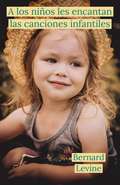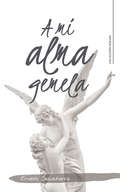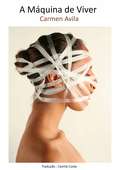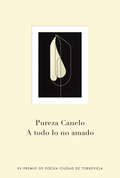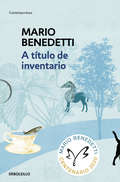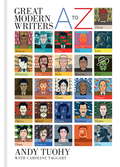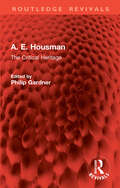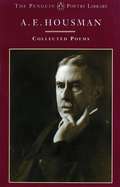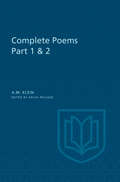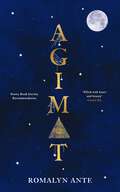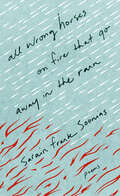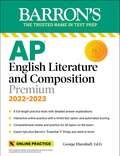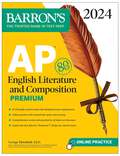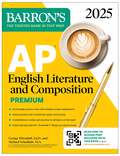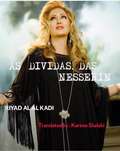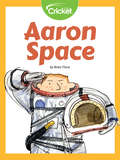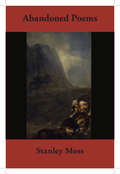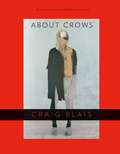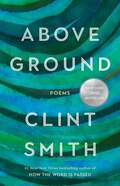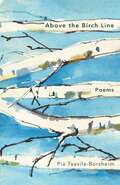- Table View
- List View
A los niños les encantan las canciones infantiles
by Bernard LevineAquí encontrarás una colección de canciones infantiles favoritas para que se las lea a sus hijos. Todas estas preciosas y queridas canciones de cuna se han transmitido de madre a hija y de padre a hijo a lo largo de los siglos. Los más pequeños adorarán y se divertirán aprendiendo y recitando estas rimas atemporales. Este es un libro que los niños atesorarán y mirarán una y otra vez.
A mi alma gemela
by Ernesto SalvatierraLa poesía es un puente áureo que une los corazones. La poesía es un río donde fluye el ansia del hombre, prisionero del tiempo. Es el bálsamo del amor que nos convierte en dioses, haciéndonos soñar con nuestra Alma Gemela. Convierte lo grande en pequeño; y en pequeño lo que es grande. Es el aliento de la vida y las alas de los ángeles caídos. La poesía es la música del alma, y un «no sé qué» que se halla por ventura. La poesía es el manantial de las ideas puras... ¡La puerta que nos abre a otros cielos!
A máquina de viver
by Carmen AvilaEsta obra foi escrita com o apoio da bolsa “Jovens Criadores” do Fundo Estadual para a Cultura e as Artes de 2005 do estado de Coahuila de Zaragoza. Foi finalista do XIII Concurso de Poesia María del Villar (Navarra, Espanha) e obteve menção honrosa no Prêmio Nacional de Poesia Jovem Francisco Cervantes Vidal de 2008, em Querétaro, México.
A todo lo no amado
by Clara Janés NadalA todo lo no amado es un canto al verso desnudo, a la poesía rigurosa, directa y honesta. Premio de Poesía Ciudad de Torrevieja 2010. Lo no amado fue y de ello nacieron ramas unas deformes todas inocentes en la complejidad de un tiempo recorrido en el universo.
A título de inventario
by Mario BenedettiEdición en un solo volumen que reúne todos los poemas de Mario Benedetti publicados entre 1950 y 2001, testimonios de la propia existencia del autor, engendrados con la sencillez y claridad que tanto le caracterizan. Amar, luchar, trabajar, morir, todo es motivo de poesía para Mario Benedetti. Cada pequeña situación del vivir cotidiano merece una canción, una celebración a la constante sorpresa de existir. Para él, la poesía no tiene sentido si no se comparte, si no se reproduce, si no fecunda. Como es habitual en las recopilaciones de la poesía de Benedetti, cada volumen se abre con la producción más reciente y concluye con la más antigua, quizá con la secreta esperanza de que el lector, al tener acceso a su obra por la puerta más nueva y más cercana, se vea luego tentado a ir abriendo otras puertas, «a beneficio de inventario». Inventario 1 integra todos los poemas publicados en libro entre 1950 y 1985:Sólo mientras tanto (1950), Poemas de la oficina (1956), Poemas del hoyporhoy (1961), Noción de patria (1963), Próximo prójimo (1965), Contra los puentes levadizos (1966), A ras de sueño (1967), Quemar las naves (1969), Letras de emergencia (1973), Poemas de otros (1974), La casa y el ladrillo (1977), Cotidianas (1979), Viento del exilio (1981) y Geografías (1984). Inventario 2 reúne todos los poemas publicados en libro entre 1986 y 1991: Preguntas al azar (1986), Yesterday y mañana (1988), Despistes y franquezas (1990) y Las soledades de Babel (1991). Inventario 3 contiene todos los poemas publicados en libro entre 1995 y 2001: El olvido está lleno de memoria (1995), La vida ese paréntesis (1998), Rincón de Haikus (1999) y El mundo que respiro (2001). Miguel García-Posada dijosobre Benedetti...«Tenía Benedetti el instinto de la palabra creadora, la capacidad de pellizcar el alma que solo poseen los poetas mayores.» «Benedetti era, aunque algunos se escandalicen, un machadiano del verso, que sabía que la poesía se produce en el tiempo o está abocada a la nada.» «Benedetti, hay que afirmarlo de entrada, y sus versos tenían, tienen, la garra de los genuinos poetas populares.»
A-Z Great Modern Writers (A-Z Great Modern series)
by Caroline TaggartA-Z Great Modern Writers is an essential reference guide to the world's most important contemporary writers, boldly illustrated by Andy Tuohy.Artist and graphic designer Andy Tuohy turns his hand to the world of modern literature in this new instalment of the A-Z series. Rendered in his distinctive style, this new book features portraits of 52 key modern writers significant for their contribution to literature, with a whole host of names from across the world including:-Simone de Beauvoir-F. Scott Fitzgerald-Kazuo Ishiguro-Doris Lessing-Salman Rushdie-Vladimir NabokovBest-selling author Caroline Taggart provides a crib sheet of everything you need to know about each author: why they are important in the field of literature, a list of their must-read books, and a surprising fact or two about them. Alongside Andy's portraits, the book features additional imagery, including book covers and author photographs.A fun, easy guide to some of the best writers of modern times, this is a great gift for anyone who wants to broaden their literary horizons.
A. E. Housman: The Critical Heritage (Routledge Revivals)
by Philip GardnerFirst published in 1992, A. E. Housman: The Critical Heritage brings together the most important and significant critical response to the poetry of A.E. Housman from the time of his writing to 1951. It contains ninety-four items—articles, reviews, and comments which provide an accurate picture of how Housman the poet was seen during his lifetime and for some years beyond it. The picture which emerges is of a poet not only of popular appeal, but of great literary distinction, who was admired by the majority of reviewers and critics who discussed his work. Among those quoted are J.B. Priestley, Edmund Gosse, Cyril Connolly, T.S. Eliot, George Orwell, Cleanth Brooke, Stephen Spender, John Sparrow, and E.M. Forster.
A.E. Housman: The Collected Poems Of A. E. Housman
by A.E. HousmanA. E. Housman, being one of the most famous and widely read poets of the early twentieth century, is certainly worthy of praise. His 'Collected Poems' are therefore a valuable read because they allow readers to gain an impression of the author's mind, opinions and lifestyle. Furthermore, they simultaneously depict a man who was deeply pessimistic and obsessed with death, and, on the other hand, illustrate a man who was also very much concerned with love, youth, life and the fleetingness of the these concepts.It is easy to understand why Housman's sensitive and sympathetic depictions of heroic English soldiers influenced and affected his readers, as his poetry is often written in an uncomplicated, yet sensitive style, which allows readers to feel as if they are witnessing events almost as the poet writes them down. These poems are also intriguing to read if you are a Shakespeare fan, as it is possible to spot many Shakespeare references in Housman's writing. A glossary or footnotes at the back of this book would be appreciated in any further editions, in order to allow readers to gain more understanding of the other poets and authors that Housman was influenced by. In brief, this collection presents the literary highlights of Housman's career, and this will be most appreciated by readers new to Housman's poetry.
A.M. Klein: Original Poems 1937-1955 and Poetry Translations
by A. M. Klein Zailig PollockIt is for his poetry that A.M. Klein is best known and most warmly remembered. This collection includes all Klein's poetry, both original works and translations from Hebrew, Yiddish, Aramaic, and Latin. Many of them, coming from all periods of his careers, have never been published.The poems are arranged chronologically according to date of composition. This makes possible, for the first time, an appreciation of Klein's poetic development. The editor's introduction places this development in the perspective of Klein's life and time, and in particular explores Klein's lifelong struggle to reconcile his dual vocations as both a Jewish and a modernist writer.The textual apparatus identifies all authoritative versions for each poem and lists all emendations and all substative variants in both published and mauscript versions. The explanatory notes gloss obscure terms and references. They also provide a rich context for appreciation and interpretation by drawing connections with Klein's life, his wide reading, and his work as a whole. Wherever possible, Klein's own numerous, but scattered, comments on his poems have been cited.
AGIMAT: ‘Spellbinding’ – Guardian
by Romalyn Ante'An alchemical wonder of a poet' Fiona Benson, author of Vertigo & Ghost'Vivid, lyrical, and always surprising . . . Both a balm and a call to action' Nathan Filer, author of The Shock of the FallA sparkling new collection from Romalyn Ante, nurse and prizewinning poet, moving between the Philippines and Wolverhampton, myth and the grind of the present-day NHS.'this charms the buried light of stars –this deflects bullets – this unblooms a war – 'In some Filipino clans, parents pass down to each child an AGIMAT, an amulet, in the hope its magic will protect and empower them. At the dawn of the pandemic, the poet – a practising nurse in the NHS – is thrown onto the frontlines of the war against COVID-19.Past conflicts swim into the now. When she falls in love with a man of Japanese heritage, it forces a reckoning with her family’s suffering under Japan’s brutal wartime occupation of the Philippines. Elsewhere, we meet the irrepressible goddess Mebuyan, who, in Philippine myth, nurses the spirits of children in the underworld. Here, she watches over young people in crisis – a girl who can’t stop cutting herself, a teenager who has leapt from a railway viaduct.These are poems of strength and solace; they question what it means to fight, and what it takes to heal.
ALL WRONG HORSES ON FIRE THAT GO AWAY IN THE RAIN (Crow Said Poetry)
by Sarain Frank SooniasA captivating search through one family’s history, All Wrong Horses on Fire that Go Away in the Rain is a stunning examination of intergenerational trauma and its effect on Indigenous voices. Aftershocks and fragmented memories ricochet through this collection, bringing with them strength, intensity and uninhibited beauty. Sarain Frank Soonias makes his poetic debut with a splash that ripples far outside his own work, and marks the entrance of a new, important voice in contemporary poetry.
AP English Literature and Composition Premium, 2022-2023: 8 Practice Tests + Comprehensive Review + Online Practice (Barron's Test Prep)
by George Ehrenhaft Ed. D.Be prepared for exam day with Barron&’s. Trusted content from AP experts! Barron&’s AP English Literature and Composition Premium: 2022-2023 includes in-depth content review and online practice. It&’s the only book you&’ll need to be prepared for exam day.Written by Experienced Educators Learn from Barron&’s--all content is written and reviewed by AP expertsBuild your understanding with comprehensive review tailored to the most recent examGet a leg up with tips, strategies, and study advice for exam day--it&’s like having a trusted tutor by your sideBe Confident on Exam DaySharpen your test-taking skills with 8 full-length practice tests--5 in the book, including a diagnostic test to target your studying, and 3 more onlineStrengthen your knowledge with in-depth review covering all Units on the AP English Literature and Composition ExamReinforce your learning with practice questions at the end of each chapter Online PracticeContinue your practice with 3 full-length practice tests on Barron&’s Online Learning HubSimulate the exam experience with a timed test option Deepen your understanding with detailed answer explanations and expert adviceGain confidence with scoring to check your learning progress
AP English Literature and Composition Premium, 2024: 8 Practice Tests + Comprehensive Review + Online Practice (Barron's AP)
by George Ehrenhaft Ed. D.Be prepared for exam day with Barron&’s. Trusted content from AP experts!Barron&’s AP English Literature and Composition Premium, 2024 includes in-depth content review and online practice. It&’s the only book you&’ll need to be prepared for exam day.Written by Experienced Educators Learn from Barron&’s--all content is written and reviewed by an AP expert.Build your understanding with comprehensive review tailored to the most recent examGet a leg up with tips, strategies, and study advice for exam day--it&’s like having a trusted tutor by your sideBe Confident on Exam DaySharpen your test-taking skills with 8 full-length practice tests--5 in the book, including a diagnostic test to target your studying, and 3 more onlineStrengthen your knowledge with in-depth review covering all Units on the AP English Literature and Composition ExamReinforce your learning with practice questions at the end of each chapter Online PracticeContinue your practice with 3 full-length practice tests on Barron&’s Online Learning HubSimulate the exam experience with a timed test option Deepen your understanding with detailed answer explanations and expert adviceGain confidence with scoring to check your learning progress
AP English Literature and Composition Premium, 2025: Prep Book with 8 Practice Tests + Comprehensive Review + Online Practice (Barron's AP Prep)
by George Ehrenhaft Ed. D. Michael SchanhalsBe prepared for exam day with Barron&’s. Trusted content from AP experts! Barron&’s AP English Literature and Composition Premium, 2025 includes in‑depth content review and practice. It&’s the only book you&’ll need to be prepared for exam day. Written by Experienced Educators Learn from Barron&’s‑‑all content is written and reviewed by AP experts Build your understanding with comprehensive review tailored to the most recent exam Get a leg up with tips, strategies, and study advice for exam day‑‑it&’s like having a trusted tutor by your side Be Confident on Exam Day Sharpen your test‑taking skills with 8 full‑length practice tests–5 in the book, including a diagnostic test to target your studying, and 3 more online–plus detailed answer explanationsand sample essays Strengthen your knowledge with key advice for answering multiple-choice questions and writing a polished essay Reinforce your learning with practice by tackling dozens of sample questions and mini-workout exercises that cover all units on the AP English Literature and Composition exam Brush up on the literary terms you should know for test day with a clear and comprehensive glossary Robust Online Practice Continue your practice with 3 full‑length practice tests on Barron&’s Online Learning Hub Simulate the exam experience with a timed test option Deepen your understanding with detailed answer explanations and expert advice Gain confidence with scoring to check your learning progress Going forward, this exam will only be offered in a digital format. Barron's AP online tests offer a digital experience with a timed test option to get you ready for test day. Visit the Barron's Learning Hub for more digital practice.
AS dividas das Nesserin
by Riyad Kadiessa e um conto de um escritor arabe iraquiano q escreveu sobre seu amor,e os poemas eram de extremo amore saudades
Aai Mere Man
by Chandra DattThe collection of poems written by Narendra Bhanawat have been composed when he was little. Whenever he got up in the night and found time, he would write whatever came into his mind. The poems have been dedicated to his family members and are related to his illness.
Aakul Antar
by Harivansh Rai BachchanAakul Antar is a collection of poems written by the famous poet. The poems have shadowism as their characteristics. Signs of romanticism and decorative language can clearly be seen in the poems.
Aaron Space
by Brian FlocaAaron Space is an astronaut! Young children will love this poem where they'll see him get to do all sorts of cool stuff in space. Being an astronaut is a lot of work, but Aaron loves his job!
Aasmaan Bahut Dur Hau
by Ramola Ruth LalPoetry that touches the land of romantic poetry. The poems of Ramola are signs of new age poetry. Her usage of words indicates the deepness of sensation. The style of writing of the poet changes quite frequently in the collection which facilitates her aims in the poems.
Aawaz Ek Tik-Tik
by Tulsi MishrThe book indicates the emptiness in life in the poetess's life. Between the happiness and the sorrows the poetess searches the meaning of life. In the loneliness of life she finds that the beginning and end of life all converges in the sound of tik tik.
Abandoned Poems
by Stanley MossStanley Moss is ninety-three years old, still kicking sixty-two-yard field goals through the uprights of American poetry. His Abandoned Poems (Paul Valery wrote, "A poem is never finished, only abandoned") consists of 120 pages of new work written since his 2016 prize-winning book, Almost Complete Poems. The truth is Moss has a unique voice in the history of American poetry. He honors the English language. This book is full of invisible life-giving discoveries the reader has almost seen, and you might say Moss has discovered a new continent, a new planet or two--or simply it's fun. There is a final section, "Apocrypha and Long Abandoned Poems," which includes early misplaced work never published, and new versions of previously published poems. Bingo.
Abirami Andhadhi
by Abirami Pattar Kavingar KannadasanWhen Abirami Pattar's life was in danger,the Goddess Abirami manifested herself before pattar to save his life and threw her thadanga over the sky such that it shined with bright light upon the horizon.The hymns on the Goddess sung by the pattar is Abhirami Andhadhi.
About Crows
by Craig BlaisAn unsentimental and at times disquieting first collection, the poems ofAbout Crowsexcavate self, family, race, location, sex, art, and religion to uncover the artifacts of a succession of traumas that the speaker does not always experience firsthand but carries with him to refashion into some new importance. This is a book of half-states, broken affiliations, and dislocation. The speaker leads the reader through the fragments of a flooded town that grows increasingly elusive the more one looks for it; through a succession of Seoul "love motels" that further displace the outsider to unclaimed margins transformed into sites of creative invention; through "galleries" of artwork, where movement, color, and image are renewed through ekphrasis; and through the world of the metatextual long poem "The Cult Poem," where good and bad moral binaries tangle into a rat's nest of our best and worst spiritual ambitions. The poems and sequences ofAbout Crowsare marked by their artistic balance of the sublime and the profane, of polyphony, syntactical complexity, clashing images, cagey humor, and unsettling sincerity, all trying desperately to connect.
Above Ground
by Clint SmithA remarkable poetry collection with "inextinguishable generosity and abundant wisdom" (Monica Youn) from Clint Smith, the #1 New York Times bestselling and National Book Critics Circle award-winning author of How the Word Is Passed. Clint Smith&’s vibrant and compelling new collection traverses the vast emotional terrain of fatherhood, and explores how becoming a parent has recalibrated his sense of the world. There are poems that interrogate the ways our lives are shaped by both personal lineages and historical institutions. There are poems that revel in the wonder of discovering the world anew through the eyes of your children, as they discover it for the first time. There are poems that meditate on what it means to raise a family in a world filled with constant social and political tumult. Above Ground wrestles with how we hold wonder and despair in the same hands, how we carry intimate moments of joy and a collective sense of mourning in the same body. Smith&’s lyrical, narrative poems bring the reader on a journey not only through the early years of his children&’s lives, but through the changing world in which they are growing up—through the changing world of which we are all a part.Above Ground is a breathtaking collection that follows Smith's first award-winning book of poetry, Counting Descent.
Above the Birch Line: Poems
by Pia Pia Taavila-BorsheimAbove the Birch Line reflects a lifetime of observation and experience, and offers glimpses of the loves, aches, and comforts that have accompanied author Pia Taavila-Borsheim along the way. Written primarily in free verse, the poems are imagistic in nature, with an ongoing metaphor of visual representations of nature, especially water. Starting with her childhood and continuing through late adulthood, Taavila-Borsheim ruminates on her parents, travels, marriage, motherhood, and finally, aging and death.
